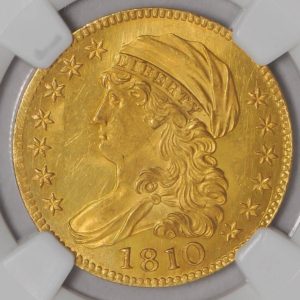Capped Bust $5 Gold Half Eagle (1807-1834)
Also known as Capped Bust to Left, the Capped Bust Half Eagle is the second series of gold coins in $5 denomination within the United States. Produced from 1807 to 1834, it can be distinguished by a common reverse design and two different obverse designs.
With the exception of 1816 and 1817, the coins were struck for circulation for each year of the series. The Capped Bust that was struck from 1807 to  1812 is the easiest to acquire today. What collectors find rare and hard to acquire are those struck from 1829 to 1834. These are also seldom offered for sale, regardless of the grade.
1812 is the easiest to acquire today. What collectors find rare and hard to acquire are those struck from 1829 to 1834. These are also seldom offered for sale, regardless of the grade.
Capped Bust (1807-1812)
In 1807, John Reich, recently hired by mint director Robert Patterson, created the Capped Bust motif featuring a buxom Miss Liberty. Being German, it’s not a surprise that Reich’s Liberty is distinctly European in looks, giving her a completely unique appearance from any previous depiction.
Reich’s signature can be seen on the obverse lowest star on the right with a characteristic notched point. Apart from the eagle with outstretched wings, the reverse side features the motto E PLURIBUS UNUM, and the inscriptions 5D and UNITED STATES OF AMERICA.
Between 1807 and 1812, the Philadelphia Mint only struck 399,013 Capped Bust half eagles, many of which were melted in later years. It is believed that only 1% of the mintage possibly survived, along with very scarce varieties of 1808/7 and 1810.
Capped Head (1813-1834)
In 1813, the European-like Miss Liberty was modified, with the bosom and drapery eliminated. The stars were also rearranged, resulting in the Capped Head design. By this time, only the half eagle was the gold coin being produced in the US.
From 1813 to 1834, the Capped Head half eagle series was minted. But due to widespread melting, much of the coins that were struck never saw circulation. A majority of them went straight from the Mint into the hands of bullion dealers.
Capped Head coins are not rare by collectors’ standards, however. This is because there are many survivors from the coin that was produced in the Philadelphia Mint.
In fact, the most commonly encountered type is the 1813 series that is dubbed as the first-year-of-issue souvenirs. Those issued in 1818 and 1820 are also occasionally available. Rarities are only afforded to Capped Head half eagles that were struck in 1814 and 1815, with only a few dozens and only 12 pieces, respectively, are known to have survived.
The more “common” date of the series is 1823.
The half eagles went through a transition in 1829, where a close collar of a steel ring with vertical grooves, was added.
Capped Head half eagles are mostly pursued by advanced collectors, what with the series’ many great rarities. Most great collections, however, have already been completed in the 19th century. The most notable of which are those of Dunham, Garrett, Jenks, Stickney, and Steigerwalt.
The Capped Bust is a mixture of common and rare coins. If your goal is to collect the rarest kind, completing your collection is challenging.
